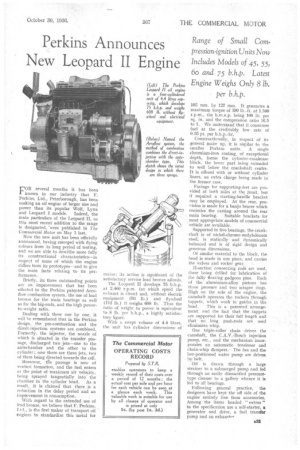Perkins Announces New Leopard II Engine
Page 41

If you've noticed an error in this article please click here to report it so we can fix it.
FOR several months it has been known in our industry that F. Perkins, Ltd., Peterborough, has been making an oil engine of larger size and power than its poplar Wolf, Lynx and Leopard I models. Indeed, the main particulars of the Leopard II, as this most recent addition to the range is designated, were published in The Commercial Motor on May 1 last.
Now the new unit has been officially announced, having emerged with flying colours from its long period of testing, and we are able to desciibe more fully its constructional characteristics—in respect of some of which the engine differs from its prototypes—and to give the main facts relating to its performance, Briefly, its three outstanding points are an improvement that has been effected to the Perkins patented Aeroflow combustion system, the use of lead bronze for the main bearings as well as for the big-ends, and the high powerto-weight ratio.
Dealing with these one by one, it will be remembered that in the Perkins design, the pre-combustion and the direct-injection systems are combined. Formerly, the injector, the nozzle of which is situated in the transfer passage, discharged two jets—one to the antechamber and the other to the cylinder ; now there are three jets, two of them being directed towards the cell. Moreover, tAe passage is now of venturi formation, and the fuel enters at the point of maximum air velocity, being sprayed tangentially into the chamber in the cylinder head. As a result, it is claimed that there is a reduction in the delay period and an hnptovement in consumption. , With regard to the extended use of lead bronze, we believe that F. Perkins. Ltd., is the first maker of transport oil engines to standardize this metal for mains ; its action is significant of the satisfactory service lead bronze affords.
The Leopard II develops 75b hp. at 9,400 r.p.m. (at -which speed the exhaust is clean) and, without electric equipment (56 lb.). and • flywheel (112 lb.) it weighs 608 lb. Thus the ratio of weight to power is equivalent to 8 lb. per blip., a highly satisfactory figure.
. With a swept volume of 4.4 litres, the unit has cylinder dimensions. of
105 mm. by 127 mm. It generates a maximum torque of 190 lb.-ft. at 1,500 r.p.m., the b.m.e.p. being 100 lb. per sq. in. and the compression ratio 16.5 to 1. We understand that it consumes fuel at the creditably low rate of 0.35 pt. per b.h.p.-hr.
Constructionally, in respect of its general make up, it is similar to the smaller Perkins units. A single chromium-iron casting, of exceptional depth, forms the cylinder-crankcase block, the lower part being extended to well below the crankshaft centre. It is offered with or without cylinder liners, an extra charge being Made in the former case, Facings for supporting-feet are provided at both sides at the front, but if required a starting-handle bracket may be employed. At the rear, provision is made for a banjo bearer which encircles the casting around the rear main bearing. Suitable brackets for most appropriate models of commercial 'vehicle are available.
Supported in five bearings, the crankshaft is of nickel-chrome-molybdenum steel, is statically and dynamically balanced and is of rigid design and generous dimensions.
Of similar material to the block, the head is made in one piece, and carries the valves and rocker gear.
H-section` connecting rods. are used, these being drilled for lubrication of the fully floating gudgeon pins. Each of the aluminium-alloy pistons -has three pressure and two scraper rings. High on the side of the engine, the camshaft operates the rockers through tappets, which work in guides, in the head. This is a patented arrangement, and the fact that the .tappets are supported for their fulllength and that no long pusharods are used eliminates whip.
One triple-roller chain drives the camshaft, the C.A.V.-Bosch injection pump, etc., and the mechanism incorporates an automatic tensioner and chain-whip dampers. a The fan and the low-positioned water pump are driven by belt.
Oil is drawn through a large strainer to a submerged pump and fed through an easily dismantled pressuretype cleaner to a gallery whence it is led to all bearings.
Following general practice, the designers have kept the oft side of the engine" entirely free from accessories. Among the items headed " extras" in the specification are a self-starter, a generator and drive, a fuel transfer pump and an exhanstia




















































































